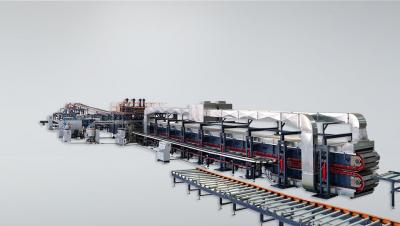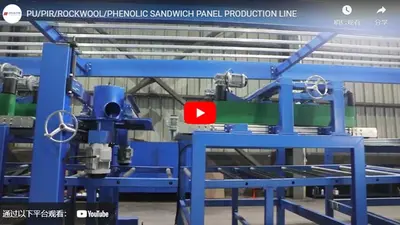What Is Sandwich Panel Construction and How to Build?
What is sandwich panel construction?
Sandwich panels are a type of construction material consisting of three layers: a core material sandwiched between two outer layers, typically referred to as skins. These panels are commonly used in various building applications due to their lightweight nature, high strength-to-weight ratio, and excellent insulation properties.
The core material of sandwich panels can be made from a variety of materials, including expanded polystyrene (EPS), polyurethane (PU), polyisocyanurate (PIR), mineral wool, or aluminum honeycomb. Each core material offers specific advantages in terms of insulation, fire resistance, and structural properties.
The outer skins of sandwich panels are usually made of metal, such as steel or aluminum, but they can also be composed of fiberglass or other composite materials. The skins provide rigidity and protect the core material from external elements. They can be coated or finished in different ways to enhance durability, aesthetics, or resistance to corrosion.
The construction process of sandwich panels typically involves the following steps:
Design and planning: Determine the dimensions, required properties (e.g., insulation, fire resistance), and structural requirements of the sandwich panels. This includes selecting the appropriate core material, skin material, and thicknesses.
Preparation of materials: Cut the core material and skins to the desired dimensions according to the design specifications. This may involve using specialized machinery or tools.
Adhesive application: Apply an adhesive or bonding agent to the surfaces of the core material and skins. The adhesive should have suitable properties to ensure strong adhesion between the layers.
Assembly: Place the core material between the two skins, aligning them properly. Apply pressure or use clamps to ensure even distribution of the adhesive and proper bonding between the layers.
Curing: Allow the adhesive to cure or harden according to the manufacturer's instructions. This may involve leaving the panels in a controlled environment, such as a curing oven, for a specific period.
Finishing: Once the adhesive has cured, any excess adhesive or protrusions can be removed, and the edges of the sandwich panels can be trimmed to achieve the desired shape and size.
Installation: The sandwich panels can be installed by fastening them to a supporting structure, such as steel frames or wooden frames, using appropriate fasteners or adhesives.
Sandwich panels find applications in various industries, including construction of walls, roofs, partitions, cold storage facilities, industrial buildings, and transportation vehicles, among others. They offer advantages such as thermal insulation, sound insulation, energy efficiency, and ease of installation.
How to build a sandwich board?
To build a sandwich board, also known as an A-frame sign or a sidewalk sign, you will need the following materials and tools:
Materials:
Plywood or any sturdy board for the sign faces
Hinges or brackets for connecting the sign faces
Screws or nails for securing the hinges or brackets
Chalkboard or whiteboard paint (optional)
Chalk or markers (depending on the paint choice)
Wood or metal frame for the sign structure (optional)
Paint or stain for the frame (if using)
Primer (if needed)
Sandpaper
Eye screws or hooks for hanging additional signage (optional)
Rope or chain (if using eye screws or hooks)
Tools:
Saw (if cutting the board to size)
Drill or screwdriver
Hammer (if using nails)
Paintbrush or roller
Sanding block or sandpaper
Measuring tape
Pencil
Here's a step-by-step guide to building a basic sandwich board:
Determine the size of the sign faces: Measure and mark the desired dimensions on the plywood or board. Use a saw to cut the board to the appropriate size if needed.
Sand and prepare the sign faces: Smooth any rough edges or surfaces using sandpaper. If desired, apply a coat of primer to the sign faces to ensure better adhesion of paint or to create a base for a chalkboard or whiteboard paint.
Paint the sign faces: Depending on your preference, you can use regular paint to create a colourful sign or apply chalkboard or whiteboard paint to create a reusable surface for writing messages. Apply multiple coats as needed, allowing each coat to dry before applying the next.
Connect the sign faces: Attach hinges or brackets to the top edges of both sign faces. Ensure that the hinges or brackets allow the sign faces to open and close easily. Use screws or nails to secure the hinges or brackets to the sign faces securely.
Optional: Build the sign structure: If you prefer a framed sandwich board, construct a wooden or metal frame that can support the sign faces. Measure and cut the frame pieces to the appropriate size, and then attach them using screws, nails, or other suitable connectors. Paint or stain the frame to your desired finish.
Attach additional features: If you want to hang additional signage or decorations, screw eye screws or hooks onto the top or sides of the sign faces. Use rope or chain to hang the additional signage securely.
Test the sandwich board: Open the sign faces to ensure they open and close smoothly. Make any necessary adjustments or tighten the screws or nails if needed.
Once your sandwich board is built, you can place it on a sidewalk, in front of a store, or at any location where it can attract attention and display your desired messages or advertisements. Remember to check any local regulations or restrictions regarding signage placement before using the sandwich board in public areas.
Boost your production efficiency with Jinggong state-of-the-art PU Sandwich Panel Line. Our PU sandwich panel machine factory offers top-quality machinery designed to meet the demands of the industry. Our advanced pu sandwich panel machine delivers high-performance results, ensuring precision and consistency in every panel produced. With our cutting-edge technology and expert craftsmanship, you can create PU sandwich panels of superior quality, making your products stand out in the market. Trust our reliable PU sandwich panel machine to streamline your production process and achieve remarkable results.


 CN
CN
 EN
EN
 fr
fr  de
de  es
es  it
it  ru
ru  pt
pt  ar
ar  th
th  pl
pl  ro
ro 







 Call us on:
Call us on:  Email Us:
Email Us:  #1809, Jianhu Rd, Keqiao, Shaoxing, Zhejiang, China
#1809, Jianhu Rd, Keqiao, Shaoxing, Zhejiang, China 